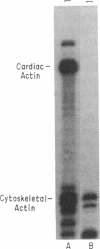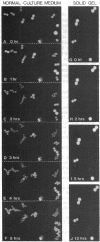Abstract
The ability of ectodermal tissue to be induced to form mesoderm is lost during gastrula stages in Xenopus embryos. We have examined the extent to which this loss of competence depends on intercellular interactions, cell division, or protein synthesis. We find that ectoderm, when separated from a whole embryo as soon as the early blastula stage, and even when dissociated into its component cells, loses its competence at the normal time. When cell division was arrested by culturing isolated cells in solid medium, the time of competence loss was unaffected. To test whether protein synthesis is required for competence loss, ectoderm was treated with cycloheximide during the normal time that competence is lost; in some cases, this treatment had no effect and in others it prolonged competence, but only slightly. We conclude that the loss of mesodermal competence is a highly autonomous process in ectodermal cells, taking place in the absence of cell communication or cell division.
Full text
PDF




Images in this article
Selected References
These references are in PubMed. This may not be the complete list of references from this article.
- Cascio S., Gurdon J. B. The initiation of new gene transcription during Xenopus gastrulation requires immediately preceding protein synthesis. Development. 1987 Jun;100(2):297–305. doi: 10.1242/dev.100.2.297. [DOI] [PubMed] [Google Scholar]
- Dale L., Smith J. C., Slack J. M. Mesoderm induction in Xenopus laevis: a quantitative study using a cell lineage label and tissue-specific antibodies. J Embryol Exp Morphol. 1985 Oct;89:289–312. [PubMed] [Google Scholar]
- Edelman G. M. Cell adhesion molecules in the regulation of animal form and tissue pattern. Annu Rev Cell Biol. 1986;2:81–116. doi: 10.1146/annurev.cb.02.110186.000501. [DOI] [PubMed] [Google Scholar]
- Godsave S. F., Anderton B. H., Wylie C. C. The appearance and distribution of intermediate filament proteins during differentiation of the central nervous system, skin and notochord of Xenopus laevis. J Embryol Exp Morphol. 1986 Sep;97:201–223. [PubMed] [Google Scholar]
- Gurdon J. B., Fairman S., Mohun T. J., Brennan S. Activation of muscle-specific actin genes in Xenopus development by an induction between animal and vegetal cells of a blastula. Cell. 1985 Jul;41(3):913–922. doi: 10.1016/s0092-8674(85)80072-6. [DOI] [PubMed] [Google Scholar]
- Jones E. A., Woodland H. R. Development of the ectoderm in Xenopus: tissue specification and the role of cell association and division. Cell. 1986 Jan 31;44(2):345–355. doi: 10.1016/0092-8674(86)90769-5. [DOI] [PubMed] [Google Scholar]
- Kintner C. R., Brockes J. P. Monoclonal antibodies identify blastemal cells derived from dedifferentiating limb regeneration. Nature. 1984 Mar 1;308(5954):67–69. doi: 10.1038/308067a0. [DOI] [PubMed] [Google Scholar]
- Leikola A. On the loss of mesodermal competence of the Triturus gastrula ectoderm in vivo. Experientia. 1965 Aug 15;21(8):458–459. doi: 10.1007/BF02150819. [DOI] [PubMed] [Google Scholar]
- Mohun T. J., Brennan S., Dathan N., Fairman S., Gurdon J. B. Cell type-specific activation of actin genes in the early amphibian embryo. Nature. 1984 Oct 25;311(5988):716–721. doi: 10.1038/311716a0. [DOI] [PubMed] [Google Scholar]
- Slack J. M., Darlington B. G., Heath J. K., Godsave S. F. Mesoderm induction in early Xenopus embryos by heparin-binding growth factors. Nature. 1987 Mar 12;326(6109):197–200. doi: 10.1038/326197a0. [DOI] [PubMed] [Google Scholar]
- Slack J. M., Isaacs H. V., Darlington B. G. Inductive effects of fibroblast growth factor and lithium ion on Xenopus blastula ectoderm. Development. 1988 Jul;103(3):581–590. doi: 10.1242/dev.103.3.581. [DOI] [PubMed] [Google Scholar]
- Smith J. C. A mesoderm-inducing factor is produced by Xenopus cell line. Development. 1987 Jan;99(1):3–14. doi: 10.1242/dev.99.1.3. [DOI] [PubMed] [Google Scholar]









